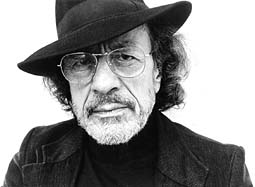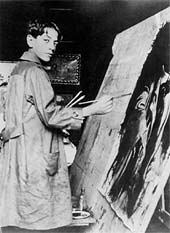

 Primo Conti | Primo Conti was born in Florence on October 16th 1900, right at the beginning of the century. His life was to be marked by the fact that, between the age of eight and nine, his precocious talent in the fields of music, poetry and painting was already showing clear signs of his genius and later, in 1913, by his meeting with the Futurists. His attraction towards the latest innovations was expressed in what were almost completely Futurist forms in his drawings, while he developed a completely new style in his painting that was a mixture of Arte Nouveau, Fauvism, Expressionism and Orphism. It was not until 1917, after his meeting with Balla in Rome and with Marinetti in Naples, who was to enthusiastically praise his book Imbottigliature, which was about to be printed, that Conti definitely became part of the Futurist movement. |
|
His fundamental contribution was to be towards this
movement, not only with his literary works, but also with the magnificent
paintings and drawings that he carried out between 1917 and 1919, the years in
which his work was already taking on a Metaphysical trend. The Twenties were a
particularly complex period for Conti, who explored Mannerism, Exoticism,
Esotercism and great historical and religious painting, covering a vast area that
can only be compared with his vivid interest in the theatrical and literary world
of Pirandello, Bontempelli and Pea, which was eventually to lead him to found the
Viareggio Award in 1929. The Thirties brought a series of alternating events that created problems in his private life and led to his great celebrative paintings; they also saw his enforced adhesion to the Fascist Party and his inner rebellion against it, which transpires from his refusal to join Margherita Sarfatti's Novecento Group and from other episodes when he stepped out of line. New prospects were only opened up to him when he became involved in designing the stage sets for the Opera House with the foundation of the Maggio Musicale Fiorentino. |
|
By the Forties, long before the official rediscovery of the Futurist movement,
which was to take place about twenty years later, Conti had already gone back to
working on Futurist subjects and experiments again. There is little doubt that
this was due to the undiminished quality of his painting and to his well known
independence from the general trends. His life history reads like a novel and was
still to produce another great coup de thÈātre: this was his spiritual crisis
which, from 1948 to 1963, made him completely subject to the rules of the III
Order of the Franciscans, though he still continued to paint. Looking at his later painting it is impossible not to remember this moment in his life which was, in the end, to change Conti completely. By trying to come to grips with his own destiny, instead of struggling to guide it, the artist discovered a joint identity with the universe, his own person and his Jungian person, and a centering around his own conscience that led to a highly sensitive understanding of his life. The Foundation, which was created thanks to his donation of his house, his archives and his works of art, is the crowning reflection of the destiny of an individual in a collective dimension, a meeting between his personal life and the history of an avant-garde that based its work on the harmony of ideas between art and life, as well as culture and its ability to transform men and society. |  Young Primo Conti at work, 1911 |

| 
| 
|

